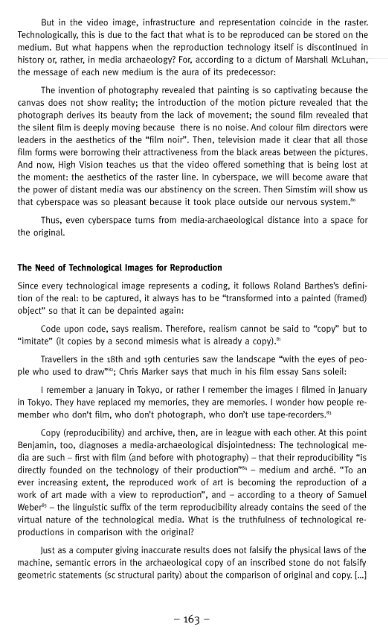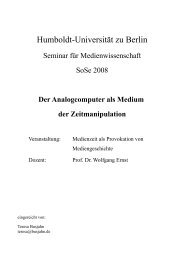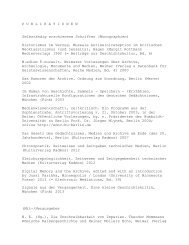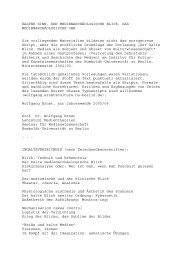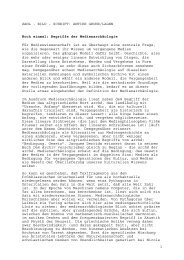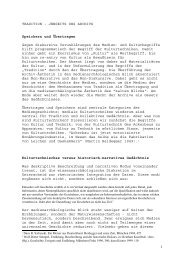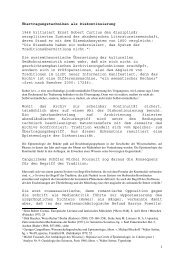Download - Medienwissenschaft
Download - Medienwissenschaft
Download - Medienwissenschaft
Create successful ePaper yourself
Turn your PDF publications into a flip-book with our unique Google optimized e-Paper software.
But in the video image, infrastructure and representation coincide in the raster.<br />
Technologically, this is due to the fact that what is to be reproduced can be stored on the<br />
medium. But what happens when the reproduction technology itself is discontinued in<br />
history or, rather, in media archaeology? For, according to a dictum of Marshall McLuhan,<br />
the message of each new medium is the aura of its predecessor:<br />
The invention of photography revealed that painting is so captivating because the<br />
canvas does not show reality; the introduction of the motion picture revealed that the<br />
photograph derives its beauty from the lack of movement; the sound film revealed that<br />
the silent film is deeply moving because there is no noise. And colour film directors were<br />
leaders in the aesthetics of the "film noir". Then, television made it clear that all those<br />
film forms were borrowing their attractiveness from the black areas between the pictures.<br />
And now, High Vision teaches us that the video offered something that is being lost at<br />
the moment: the aesthetics of the raster line. In cyberspace, we will become aware that<br />
the power of distant media was our abstinency on the screen. Then Simstim will show us<br />
that cyberspace was so pleasant because it took place outside our nervous system. 80<br />
Thus, even cyberspace turns from media-archaeological distance into a space for<br />
the original.<br />
The Need of Technological Images for Reproduction<br />
Since every technological image represents a coding, it follows Roland Barthes's definition<br />
of the real: to be captured, it always has to be "transformed into a painted (framed)<br />
object" so that it can be depainted again:<br />
Code upon code, says realism. Therefore, realism cannot be said to "copy" but to<br />
"imitate" (it copies by a second mimesis what is already a copy). 81<br />
Travellers in the 18th and 19th centuries saw the landscape "with the eyes of people<br />
who used to draw" 82 ; Chris Marker says that much in his film essay Sans soleil:<br />
I remember a January in Tokyo, or rather I remember the images I filmed in January<br />
in Tokyo. They have replaced my memories, they are memories. I wonder how people remember<br />
who don't film, who don't photograph, who don't use tape-recorders. 83<br />
Copy (reproducibility) and archive, then, are in league with each other. At this point<br />
Benjamin, too, diagnoses a media-archaeological disjointedness: The technological media<br />
are such - first with film (and before with photography) - that their reproducibility "is<br />
directly founded on the technology of their production" 84 - medium and arche. "To an<br />
ever increasing extent, the reproduced work of art is becoming the reproduction of a<br />
work of art made with a view to reproduction", and - according to a theory of Samuel<br />
Weber 85 - the linguistic suffix of the term reproducibility already contains the seed of the<br />
virtual nature of the technological media. What is the truthfulness of technological reproductions<br />
in comparison with the original?<br />
Just as a computer giving inaccurate results does not falsify the physical laws of the<br />
machine, semantic errors in the archaeological copy of an inscribed stone do not falsify<br />
geometric statements (sc structural parity) about the comparison of original and copy. [...]<br />
- 163 -


